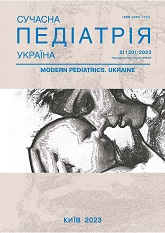Detection and treatment of skin infection with Staphylococcus aureus in children with atopic dermatitis
DOI:
https://doi.org/10.15574/SP.2023.130.74Keywords:
atopic dermatitis, Staphylococcus aureus, single nucleotide polymorphism, thyrothricinAbstract
Introduction. Atopic dermatitis is a common chronic relapsing inflammatory multifactorial skin disease. Staphylococcus aureus skin colonization increases during disease outbreaks and correlates with the severity of skin symptoms.
Purpose - to evaluate the effectiveness of thyrothricin gel as an adjuvant therapy in the treatment of atopic dermatitis and the influence of polymorphisms of pattern recognition receptors on the achieving a therapeutic effect.
Materials and methods. This study included patients with atopic dermatitis (n=37) aged 2-18 years from the Allergy Department of the Kyiv City Children’s Clinical Hospital No. 2. Patients were devided into two groups: a group that received thyrothricin gel on the affected skin areas 2 times a day for 7 days (the Group A) and a control group (the Group B) that received only basic symptomatic therapy. SCORAD (SCORing AD) and CDLQI (Children’s Quality of Life Index in Dermatology) scores were recorded before and after treatment, side effects were recorded during the study. Skin swabs were taken in the Group A before and after treatment. Genotyping of polymorphisms rs4696480 in the TLR2 gene, rs7309123 in the Dectin-1 gene were performed using polymerase chain reaction.
Results. In both groups of children, improvement was observed in 7 days after treatment (p<0.001). In the Group A, the improvement in ΔSCORAD was 16.6±5.9 points, in the Group B - 8.1±4.5 points. The difference in ΔSCORAD scores between the Groups A and B was statistically significant (W=225.0, p<0.001). The decrease in CDLQI score after treatment was 3.8±1.8 points in the Group A and 2.3±1.25 points in the Group B. A significant decrease in CDLQI score was demonstrated in the intervention group than in the control group after treatment (W=275.5, p=0.004). After treatment, a bacteriological examination of the skin demonstrated the eradication of Staphylococcus aureus: in the Group A, 94.4% of patients were Staphylococcus aureus-negative. Polymorphisms rs4696480 in the TLR2 gene and rs7309123 in the Dectin-1 gene did not affect the speed of achieving the therapeutic effect.
Conclusions. The addition of thyrothricin to standard therapy for atopic dermatitis in children with Staphylococcus aureus infection of affected skin may provide significant clinical benefit in SCORAD and CDLQI scores.
The research was carried out in accordance with the principles of the Helsinki Declaration. The study protocol was approved by the Local Ethics Committee of the participating institution. The informed consent of the patients was obtained for conducting the studies.
No conflict of interests was declared by the author.
References
Bath-Hextall FJ, Birnie AJ, Ravenscroft JC, Williams HC. (2010, Jul). Interventions to reduce Staphylococcus aureus in the management of atopic eczema: an updated Cochrane review. Br J Dermatol. 163 (1): 12-26. Epub 2010 Mar 5. https://doi.org/10.1111/j.1365-2133.2010.09743.x; PMid:20222931
Besh LV. (2012). External therapy of atopic dermatitis in children: a modern approach to the problem. Child's health. 8 (43): 108-110. https://doi.org/10.22141/2224-0551.0.8.43.2012.192323
Khadka VD, Key FM, Romo-González C et al. (2021, Sep 24). The Skin Microbiome of Patients With Atopic Dermatitis Normalizes Gradually During Treatment. Front Cell Infect Microbiol. 11: 720674. https://doi.org/10.3389/fcimb.2021.720674; PMid:34631601 PMCid:PMC8498027
Maarouf M, Shi VY. (2018, May/Jun). Bleach for Atopic Dermatitis. Dermatitis. 29 (3): 120-126. https://doi.org/10.1097/DER.0000000000000358; PMid:29762205
Montravers P, Snauwaert A, Welsch C. (2016). Current guidelines and recommendations for the management of skin and soft tissue infections. Curr Opin Infect Dis. 29: 131-138. https://doi.org/10.1097/QCO.0000000000000242; PMid:26779771
Simpson EL, Villarreal M, Jepson B et al. (2018). Patients with atopic dermatitis colonized with Staphylococcus aureus have a distinct phenotype and endotype. J. Investig. Dermatol. 138: 2224-2233. https://doi.org/10.1016/j.jid.2018.03.1517; PMid:29604251 PMCid:PMC6153055
Stauss-Grabo M, Atiye S, Le T, Kretschmar M. (2014). Decade-long use of the antimicrobial peptide combination tyrothricin does not pose a major risk of acquired resistance with gram-positive bacteria and Candida spp. Die Pharmazie. 69 (11): 838-841. PMID: 25985581.
Tamagawa-Mineoka R, Katoh N. (2020, Apr 11). Atopic Dermatitis: Identification and Management of Complicating Factors. Int J Mol Sci. 21 (8): 2671. https://doi.org/10.3390/ijms21082671; PMid:32290423 PMCid:PMC7215488
Totté JE, van Doorn MB, Pasmans SG. (2017). Successful treatment of chronic Staphylococcus aureus-related dermatoses with the topical endolysin Staphefekt SA. 100: A report of 3 cases. Case Rep. Dermatol. 9: 19-25. https://doi.org/10.1159/000473872; PMid:28611631 PMCid:PMC5465516
Volosovets OP, Bolbot YuK, Beketova GV et al. (2021). Allergic and non-allergic skin diseases in children of Ukraine: a retrospective study of the prevalence and incidence over the past 24 years. Medicni perspektivi. 26 (3): 188-196. https://doi.org/10.26641/2307-0404.2021.3.242319
Volosovets ОP, Bolbot YuK, Beketova GV, Berezenko VS et al. (2021). Allergic march in children of Ukraine. Medicni perspektivi. 26 (4): 181-188.
Downloads
Published
Issue
Section
License
Copyright (c) 2023 Modern pediatrics. Ukraine

This work is licensed under a Creative Commons Attribution-NonCommercial 4.0 International License.
The policy of the Journal “MODERN PEDIATRICS. UKRAINE” is compatible with the vast majority of funders' of open access and self-archiving policies. The journal provides immediate open access route being convinced that everyone – not only scientists - can benefit from research results, and publishes articles exclusively under open access distribution, with a Creative Commons Attribution-Noncommercial 4.0 international license (СС BY-NC).
Authors transfer the copyright to the Journal “MODERN PEDIATRICS. UKRAINE” when the manuscript is accepted for publication. Authors declare that this manuscript has not been published nor is under simultaneous consideration for publication elsewhere. After publication, the articles become freely available on-line to the public.
Readers have the right to use, distribute, and reproduce articles in any medium, provided the articles and the journal are properly cited.
The use of published materials for commercial purposes is strongly prohibited.

